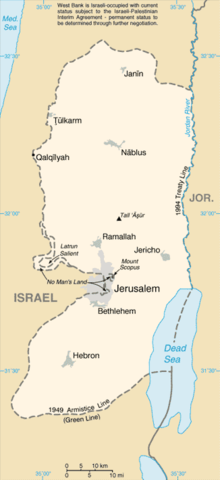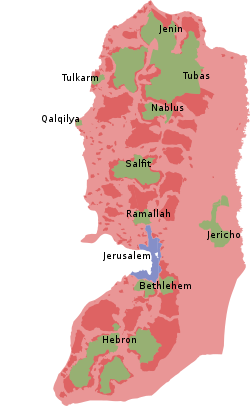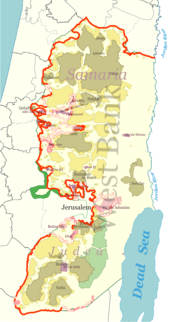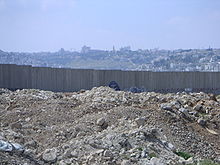West Bank
![]()
West Bank is a redirect to this article. For other meanings, see West Bank (disambiguation).
The West Bank (Arabic الضفة الغربية, DMG aḍ-Ḍaffa al-Ġarbiyya, aḍ-Ḍiffa al-Ġarbiyya, Hebrew הגדה המערבית haGada haMa'arawit) or West Bank (English West Bank), also Cisjordan, in Israel officially Judea and Samaria (Hebrew יהודה ושומרון Jehuda we-Shomron), is an area in the Near East west of Jordan and east of Israel, with an area of about 5800 square kilometers; of which about 220 square kilometers is water. Of the area's estimated 2012 population of about 2.4 million, 83 percent are Palestinian and 17 percent are Jewish, living in an estimated 355 Israeli settlements and their outposts.
The area is known in the Bible as the settlement area of various Canaanite peoples, namely the Phoenicians, the Samaritans and the Hebrews. The latter also founded the kingdoms of Israel and Judah. In the course of its several thousand year history, the area was often conquered and occupied; parts of it belonged to the ancient empires of Assur, Egypt, Persia and Rome, and later to the Abbasid Caliphate, the Ottoman Empire and the British Empire.
As part of the British League of Nations Mandate for Palestine, the West Bank was awarded by the UN General Assembly in the partition plan of 1947 to the Arab state to be founded. It was occupied by Jordan in the Arab-Israeli War of 1948 and annexed in 1950. It was captured by Israel in the Six-Day War of June 1967 and has been under Israeli military administration ever since. East Jerusalem and the surrounding area, on the other hand, were annexed by Israel in 1980 - in violation of international law, according to a UN Security Council resolution. Since 1993, parts of the West Bank, including the cities of Jericho, Nablus, Jenin, Tulkarem, Qalqilya, Ramallah, Bethlehem and 80% of Hebron, have been administered by the Palestinian National Authority (PNA).

West Bank

Palestinian self-governing territory, "Area A" under the Interim Agreement on the West Bank and the Gaza Strip (Oslo Agreement), Palestinian self-governing territory under the control of the Israeli military (Area B). Administered by the Israeli military (Area C); Israeli settlement, Outpost of an Israeli settlement, communal area of the settlement (forbidden to Palestinians).

Status of the West Bank territories in accordance with the Oslo Accords: Territory annexed by Israel Area A : Palestinian police and civilian control Area B : Israeli-Palestinian police and Palestinian civilian control Area C : Israeli police and civilian control
Term History
The most common name for this part of Palestine worldwide since the middle of the last century is the English name West Bank, also called West Bank in German. These terms refer to the land west of the Jordan River and the state of (Trans)Jordan. Bank stands for the English word for bank, embankment.
The terms West Bank and East Bank were coined by Jordanian King Abdallah I, who translated these English terms into Arabic, where they became popular, and from which they were then translated back into English.
At the time of British rule (League of Nations Mandate for Palestine), the terms Cis-Jordan and Trans-Jordan, also West and East Palestine were in common use. Both Winston Churchill and the politician Zeev Jabotinsky spoke of "the two banks of the river". East Palestine, also called the East Bank, was separated from Mandate Palestine by the British and became an emirate under the name Transjordan, gaining independence in 1946 as the Kingdom of Transjordan. In the first Arab-Israeli war of 1948, Transjordan captured the eastern part of Jerusalem and large parts of the area of western Palestine designated as an Arab state in the UN partition plan. After the military occupation and subsequent annexation of the territories of Western Palestine conquered in 1948, the state was renamed in 1950 and henceforth called the Hashemite Kingdom of Jordan. Today, the Arab state of Jordan has finally returned all claims to its former occupied territory. The name Cisjordan, which is still in use today in Romance languages, translates as on this side of the Jordan River; by analogy, Transjordan means on the other side of the Jordan River.
"Judea and Samaria" as a designation for the whole area goes back to the New Testament and was also used in reverse order. Sometimes names like the hill country of Samaria or Judea were and are used.
The original names Yehudah and Shomron are already found in the Jewish Bible. Jehudah, in Greek and Latin Judea, is the hill area south of Jerusalem, Shomron, in Greek and Latin Samaria, that north of the city to south of Galilee. In Israel, the area has been referred to as Judea and Samaria (Yehuda we'Shomron) in official publications since the 1970s.

Area of the League of Nations Mandate for Palestine in the borders from 1920 to 1923 (orange) as the former intended home for the Jewish people
Borders
The West Bank has a border of 404 kilometres, 307 kilometres of which are with Israel and 97 kilometres with Jordan. It is demarcated from Jordan by the Jordan River and the Dead Sea, and has no natural boundary with Israel. The 1949 armistice line, often referred to as the Green Line, runs south from the Sea of Galilee in an arc towards Jerusalem, which it cuts through, and reaches the Dead Sea in another arc southeast of Hebron.
Resolution 242 in November 1967, in addition to the withdrawal of Israeli forces from (the) territories occupied during the recent conflict, stresses the right of every state in the region to "secure and recognized borders free from threats or acts of violence."
Since 2003, the Israeli government's construction of the Israeli barrier, which runs only in a few places along the Green Line and cuts deep into the West Bank at the larger Israeli settlement blocs, has been the subject of sometimes fierce criticism. Israel justifies the fence-like barrier, which is designed as a protective wall in a few places, with the protection of Israeli territory and Israeli citizens from radical Islamic Arab terrorists and suicide bombers, and describes the barrier as provisional. More than 1,000 Israelis were killed in attacks by Palestinians on Israeli buses, nightclubs and coffee houses. The terror war lost intensity as peace negotiations dragged on, but also because Israel sealed off the West Bank from Israel with the barrier, which makes uncontrolled border crossings very difficult.
The barrier cuts transport routes and temporarily dispossesses residents. This is clearly evident in the area east of Jerusalem and near Qalqiliya, where access to the Arab heartland is made more difficult for the Arab majority population of large Arab conurbations, in order to protect the Jewish minority population from Arab terrorist attacks and suicide bombings. The official Palestinian side, on the other hand, warns against a planned annexation. An expert opinion commissioned by the International Court of Justice in The Hague comes to the conclusion that the separation of territories from the heartland by the barrier is illegal.

Barrier course 2011

Barrier: mainly a security fence (here south of Hebron)

Barrier near Jewish settlements: stronger security fortification in a few places
Search within the encyclopedia